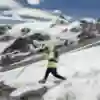Summary
- 1Five down, two to go
- 2She used to work as an environmental lawyer
- 3She's inspired by the star of Free Solo
- 4She also aspires to perfection… like Nadia Comaneci
- 5Her dream is to run and climb up Mount Everest
- 6Her grandfather tried to return to jiu jitsu aged 75!
- 7She ran to school because it was quicker and cheaper than the bus
- 8She feared she'd gone blind when climbing the Matterhorn…
- 9Her flatmate Gonzalo also lost his life on the same mountain
- 10The day after conquering the Matterhorn, a huge landslide struck it
- 11Her goal is to help people and save the planet by running
Fernanda Maciel has once again redefined the limits of human endurance by setting the Fastest Known Time (FKT) on the highest peak in Oceania, Carstensz Pyramid. The 4,884m peak, also known as Puncak Jaya, is situated on the island of New Guinea in Indonesia.
Covering 3.41km from Base Camp at 4,300m, she climbed 582m vertically to the peak, over rugged limestone, in just 1h 4m. Her entire round trip, completed in 1h 48m, now stands as the record, verified by SkyRunning World Records.
Watch how she got on in the video below:
After her mental and physical feat, here are 11 things you need to know about the Brazilian.
01
Five down, two to go
Speaking after setting the Fastest Known Time on Carstensz Pyramid, Maciel said "Carstensz Pyramid was both technically demanding and exhilarating. It’s a special summit… and it challenged me in ways I hadn’t expected." However tough a feat it was, though, it's just a small part of the challenge Maciel has set herself. Her aim is to set FKTs on each of the 'Seven Summits' - the highest peaks on each of the seven continents - and so far she has chalked five of them off the list:
The two remaining peaks are Denali (North America) and, of course, Everest (Asia), which Maciel is aiming to take on in 2026.
02
She used to work as an environmental lawyer
Before committing herself full-time to ultrarunning, Maciel worked in the legal field focusing on the environment in her native Brazil. It was something she did for five years but, 15 years ago, she decided to walk away.
Of that former work, she said: “I don’t miss this, as I chose to leave my job as a lawyer. When you work for the state and the country, you realise that there’s lots of politics involved, so much bureaucratic stuff.”
However, her previous role does inform her motivation for completing her personal seven summits challenge. Each summit brings attention to the planet’s most fragile ecosystems, aiming to inspire collective action for preservation and sustainability. "My goal is not just to set records but to show the beauty and resilience of these environments. I hope people can see the power of nature through my journeys and feel motivated to protect it,” she says.
03
She's inspired by the star of Free Solo
The Brazilian has two main role models within her running and climbing fields: one is pioneering ski-mountaineer Hilaree Nelson, the other is Alex Honnold, who famously became the first man to free solo Yosemite’s El Capitan, which turned into the Oscar-winning film Free Solo.
But it's less their sporting feats than other things that have inspired her. She said: “Take Alex, he’s created his foundation and I support that. I think it’s very interesting as an athlete to be able to help.”
04
She also aspires to perfection… like Nadia Comaneci
Growing up, Maciel was a budding gymnast – her first real sporting passion – and her inspiration was Nadia Comaneci, the Romanian gymnast who famously achieved the first clean sweep of perfect 10s to win Olympic gold back in 1976.
“She was the only one that had perfection,” said Maciel. ”And that must have taken so much training as well. Some sports you can train and be a champion, but, with gymnastics, it’s crazy, there’s so much training but also skills. She, for me, was really achieving the maximum of her potential.”
05
Her dream is to run and climb up Mount Everest
If money were no object, the 40-year-old says that tackling Everest and running up it where possible would be the dream achievement.
Whether it's something she'll pull off, she has no idea. She said: “My dream project is Everest, but that's a lot of money. I hope I can do it in the future. I really need to get more experience. Next year I aim to run 8,000m in the high mountains because I need to get this high mountain experience and also to know my speed.”
That dream is now inching closer to becoming reality, with an attempt on Everest pencilled in for 2026.
06
Her grandfather tried to return to jiu jitsu aged 75!
Maciel’s gene pool is not one of ultrarunners or climbers, instead their sporting background comes in the world of martial arts.
Her grandfather was a jiu jitsu champion while her father turned into a master of capoeira. However, her and the family had to rein in grandpa with regards to martial arts in later life. She added: “My grandfather tried to return to fighting when he was 75, but it was too dangerous!”
Since I was 15 years old, I knew my mission in the world was to protect the environment
07
She ran to school because it was quicker and cheaper than the bus
When Maciel was still in school, she decided to put on her running shoes as the best way to get to class.
She explained: “It was faster running than getting the bus and I didn’t want to ask my dad for money for the bus! So, I went there and came back running to my house. It’s built on the hills so it was up and down – that was hard, very steep.”
08
She feared she'd gone blind when climbing the Matterhorn…

At 4,478m of altitude, the Matterhorn entailed personal tragedy and her own hospitalisation for Maciel, but she conquered her own demons to reach its top in the same 24 hours as having climbed Gran Paradiso.
On a previous Matterhorn attempt, the conditions were so bad that her eyelids were frozen shut and she feared she was going blind.
Recalling that moment, she said: “I couldn’t open my eyes and I was alone for three days in this hospital bed. I was in this hospital where no one spoke English. But the second day an Italian nurse and I could speak and she got my mobile to call a friend and explain that I was there. That time I thought I was becoming blind – the scariest moment of my life in that hospital.”
09
Her flatmate Gonzalo also lost his life on the same mountain
Tragedy struck for Maciel when her Argentinian flatmate died while taking a British client up the infamous Matterhorn, which made climbing it herself an even more “emotional challenge”.
She remembered: “I lost Gonzalo. We had dinner one day before and I was leaving for a race in Austria. I arrived there and a colleague said a big rock had fallen and killed Gonzalo and his English client. That had a big impact on me and I couldn’t race well.”
10
The day after conquering the Matterhorn, a huge landslide struck it
Maciel was weighing up whether to take on her Gran Paradiso-Matterhorn double challenge on the Thursday or Friday of the week in question. She opted for the Thursday, a wise move bearing in mind the events of the next day.
She revealed: “On the Friday, a helicopter had to rescue 20 alpinists because of a landslide. I had so much luck on what’s a dangerous mountain. There are so many rock falls there with climate change.”
11
Her goal is to help people and save the planet by running

Aside from her various expeditions, climate change is the thing that drives her both in those sporting quests, but also in her wider life.
Explaining her green approach to sport and wider life, she said: “Since I was 15 years old, I knew my mission in the world was to protect the environment. I love nature and feel at home in the mountains. That’s my house and this is why I have so much pleasure there. I think it’s a better job inspiring people in the mountains – more positives than working inside like before.
“It’s always a running challenge, but it’s a social point as well, like protecting the winter and showing there are fewer glaciers. Like with the Matterhorn, each year it’s more dangerous with crevasses and more landslides. You can see climate change happening.”
My goal is not just to set records but to show the beauty and resilience of these environments
During her seven summits challenge, Maciel not only sets records but also brings attention to pressing issues in some of the world’s most remote locations. For example, on Kilimanjaro, in addition to setting the women’s FKT, Maciel visited the Kilimanjaro Orphanage Centre, offering support to local children.
While setting a record on Mount Vinson, she collaborated with the Antarctic Science Foundation to study climate change’s impact on plankton, spotlighting fragile ecosystems affected by rising global temperatures.
During the trip to tackle Mt Elbrus in Russia, she supported Crisiscenter.ru, an organisation that aids women who have survived violence, combining her physical achievements with social advocacy.
In South America, she engaged with Mendoza officials to raise awareness on sustainable waste management for Aconcagua Park, addressing the heavy impact of climbers on the region’s environment.




















